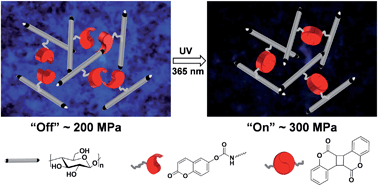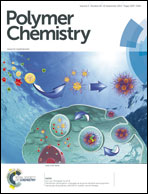Photoswitchable nanocomposites made from coumarin-functionalized cellulose nanocrystals†
Abstract
Coumarin derivatives can undergo dimerization reactions upon exposure to ultraviolet (UV) light with a wavelength of >300 nm. We exploited this effect to develop mechanically adaptive nanocomposites in which UV light can be used to change the material properties. Thus, cellulose nanocrystals (CNCs) derived from tunicates were functionalized with 7-coumaryl-(6-isocyanatohexyl) carbamate to afford coumarin-derivatized CNCs (Cou-CNCs). Light-responsive nanocomposites were prepared by reinforcing a rubbery ethylene oxide–epichlorohydrin copolymer (EO–EPI) matrix with Cou-CNCs. The as-prepared nanocomposites show a significantly increased tensile storage modulus (E′) in comparison to the neat EO–EPI. For example, E′ at 25 °C increased from 4 MPa to 199 MPa upon introduction of 10% w/w Cou-CNCs. E′ increased further to 291 MPa upon irradiation with 365 nm UV light, whereas control nanocomposites with neat CNCs did not display any significant increase in E′ under the same conditions. The optically induced reaction between Cou-CNCs also reduced the swelling of the EO–EPI/Cou-CNC nanocomposites upon exposure to water as well as the extent of water-induced softening.


 Please wait while we load your content...
Please wait while we load your content...